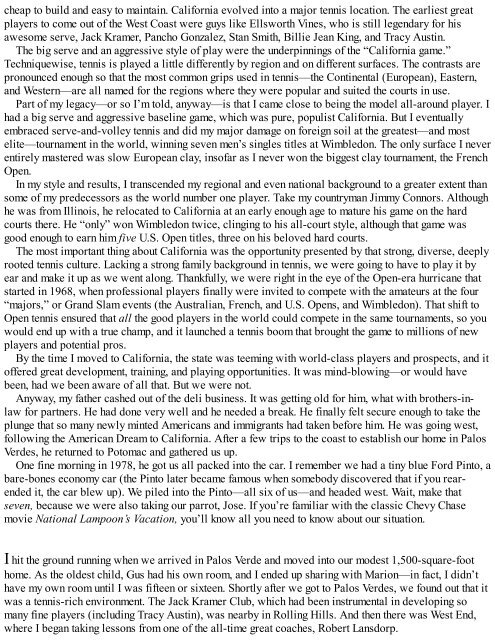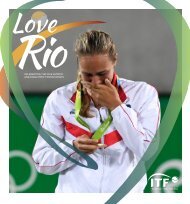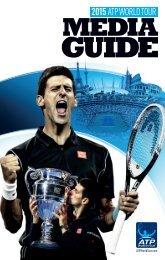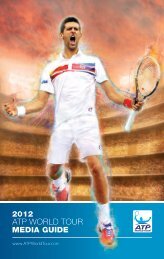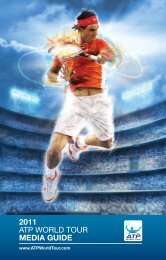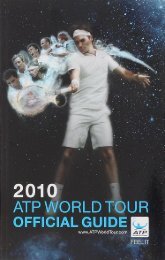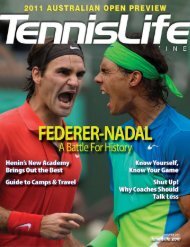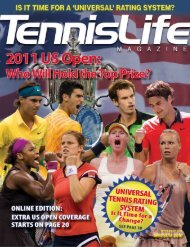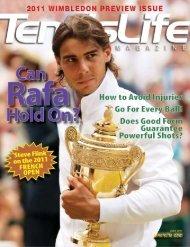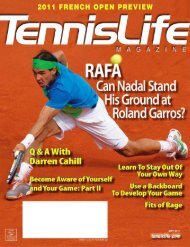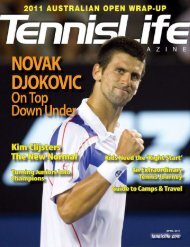A Champion's Mind - Pete Sampras
www.tennismoscow.me Insta:TENNISMOSCOW
www.tennismoscow.me Insta:TENNISMOSCOW
Create successful ePaper yourself
Turn your PDF publications into a flip-book with our unique Google optimized e-Paper software.
cheap to build and easy to maintain. California evolved into a major tennis location. The earliest great<br />
players to come out of the West Coast were guys like Ellsworth Vines, who is still legendary for his<br />
awesome serve, Jack Kramer, Pancho Gonzalez, Stan Smith, Billie Jean King, and Tracy Austin.<br />
The big serve and an aggressive style of play were the underpinnings of the “California game.”<br />
Techniquewise, tennis is played a little differently by region and on different surfaces. The contrasts are<br />
pronounced enough so that the most common grips used in tennis—the Continental (European), Eastern,<br />
and Western—are all named for the regions where they were popular and suited the courts in use.<br />
Part of my legacy—or so I’m told, anyway—is that I came close to being the model all-around player. I<br />
had a big serve and aggressive baseline game, which was pure, populist California. But I eventually<br />
embraced serve-and-volley tennis and did my major damage on foreign soil at the greatest—and most<br />
elite—tournament in the world, winning seven men’s singles titles at Wimbledon. The only surface I never<br />
entirely mastered was slow European clay, insofar as I never won the biggest clay tournament, the French<br />
Open.<br />
In my style and results, I transcended my regional and even national background to a greater extent than<br />
some of my predecessors as the world number one player. Take my countryman Jimmy Connors. Although<br />
he was from Illinois, he relocated to California at an early enough age to mature his game on the hard<br />
courts there. He “only” won Wimbledon twice, clinging to his all-court style, although that game was<br />
good enough to earn him five U.S. Open titles, three on his beloved hard courts.<br />
The most important thing about California was the opportunity presented by that strong, diverse, deeply<br />
rooted tennis culture. Lacking a strong family background in tennis, we were going to have to play it by<br />
ear and make it up as we went along. Thankfully, we were right in the eye of the Open-era hurricane that<br />
started in 1968, when professional players finally were invited to compete with the amateurs at the four<br />
“majors,” or Grand Slam events (the Australian, French, and U.S. Opens, and Wimbledon). That shift to<br />
Open tennis ensured that all the good players in the world could compete in the same tournaments, so you<br />
would end up with a true champ, and it launched a tennis boom that brought the game to millions of new<br />
players and potential pros.<br />
By the time I moved to California, the state was teeming with world-class players and prospects, and it<br />
offered great development, training, and playing opportunities. It was mind-blowing—or would have<br />
been, had we been aware of all that. But we were not.<br />
Anyway, my father cashed out of the deli business. It was getting old for him, what with brothers-inlaw<br />
for partners. He had done very well and he needed a break. He finally felt secure enough to take the<br />
plunge that so many newly minted Americans and immigrants had taken before him. He was going west,<br />
following the American Dream to California. After a few trips to the coast to establish our home in Palos<br />
Verdes, he returned to Potomac and gathered us up.<br />
One fine morning in 1978, he got us all packed into the car. I remember we had a tiny blue Ford Pinto, a<br />
bare-bones economy car (the Pinto later became famous when somebody discovered that if you rearended<br />
it, the car blew up). We piled into the Pinto—all six of us—and headed west. Wait, make that<br />
seven, because we were also taking our parrot, Jose. If you’re familiar with the classic Chevy Chase<br />
movie National Lampoon’s Vacation, you’ll know all you need to know about our situation.<br />
I hit the ground running when we arrived in Palos Verde and moved into our modest 1,500-square-foot<br />
home. As the oldest child, Gus had his own room, and I ended up sharing with Marion—in fact, I didn’t<br />
have my own room until I was fifteen or sixteen. Shortly after we got to Palos Verdes, we found out that it<br />
was a tennis-rich environment. The Jack Kramer Club, which had been instrumental in developing so<br />
many fine players (including Tracy Austin), was nearby in Rolling Hills. And then there was West End,<br />
where I began taking lessons from one of the all-time great coaches, Robert Lansdorp.


